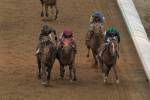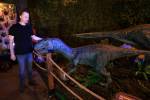Bond between 2 racehorses puzzles even veteran stable hands
LAMBOURN, England — Sixty miles west of London in the “Valley of the Racehorse,” some human beings in recent years have dug out the word “extraordinary” and put it to use.
For horse people, that’s something, for they so often bring understated temperaments to their work among breathtaking animals. They live steadily through unforgiving daily routines that might bore or addle many but seem utterly indispensable to them. They’ve seen it all, or at least close to it, yet even they say they hadn’t quite seen what blossomed and flourished here.
Like all other humans, they can’t sort out what to make the wretched events since Nov. 13, 2016, which wreaked a mystery almost as old as dirt.
They just know that when famed trainer Nicky Henderson of Seven Barrows Farm sent the usual 40 or 50 thoroughbreds to nearby Hillwood Stud one summer early in the decade, and Charlie and Tracy Vigors sent 10 of the horses out into a field, two of those 10, who hadn’t mingled at Seven Barrows, became inseparable. They know that while they all had seen inseparable before, they had not seen quite this level of inseparable.
“We always have 10 horses in that field,” Henderson said this past summer. “And that time there were very good horses in there. There was Bobs Worth, who won the [Cheltenham] Gold Cup, Finian’s [Rainbow], who had won the [Queen Mother] Champion Chase. I mean, they were some of the best horses in the country. And Simonsig and Triolo, and it must have been the next day, I went down to [the farm], it’s only a quarter of an hour away. And I went over to see them, and there were eight bays, stood together” - referring to reddish-brown horses with black manes and tails.
“I mean, it must be color. Had to be about color, didn’t it?” Henderson continued. “Because the bays were all in a pack, and 500 yards away, on their own, were the gray [Simonsig] and the chestnut [Triolo D’Alene]. And they just spent the whole summer like that together.”
Per usual, they returned post-summer. Per usual, they went about their autumns and winters separately. Per unusual, the moment they returned to Hillwood the next summer, they reconvened intricately. Both were males. Both were geldings. Both were habitual winners at jump racing. Simonsig, foaled in May 2006, would win eight of 13 races in his career. Triolo D’Alene, foaled in May 2007, would win the Hennessy Gold Cup among six triumphs.
“They started segregating themselves off together,” Tracy Vigors said. “It was quite apparent quite quickly they were very much bestie-mates, I suppose you would say… . They would stand together, eat together, walk together, trough together, eat out of the same food manger… . They were like best friends in the human variety, who go to the pub together, who go shopping together… . You see dogs cuddled up together. They were almost like that.” They would rest heads across each other, scratch each other’s backs, share the food pot (“Most horses would go mad,” Vigors said), and amuse and enchant the farmworkers.
Soon, they became even roomies.
Both had breathing problems, and Henderson had “a big box,” as he called their stall, a big opening for air at its front. “So we left them in there together,” Henderson said while standing with Dave Fehily, the groom who worked closely with Simonsig. “And, I mean, it was the most extraordinary relationship, wasn’t it? And, I mean, most horses, if you put them in a box together, you’d have to take the hind shoes off, because it would be too dangerous.
“But you knew they weren’t going to kick each other.”
The rare arrangement did pack an inconvenience: The sharing of food does blur a trainer’s capacity to assess who is eating properly. Triolo D’Alene did fatten sometimes. Simonsig did seem unable to gain weight. Henderson put a camera on them. It detected little. “We never knew who was eating what,” he concluded.
Convenience-wise, then, Triolo D’Alene, whom Vigors called “a genuinely nice person as a horse,” became the method by which Fehily could coax in from the field the elusive Simonsig, whom Henderson called “a very, very shy horse.” If Simonsig hesitated at eating apples, said Sophie Waddilove at Seven Barrows, Triolo D’Alene’s willingness to gobble could encourage Simonsig. Pointing to a smallish pasture, Waddilove said, “They used to get turned out here… . And it’s just such a simple way they lived. That’s why I got so fond of them… . And you’d find the pair of them lying down together in here. Like two sort of children, you know, heads together and that sort of thing.”
Debbie Marsden, a Scotland-based consultant on equine behavior, found “very, very interesting” the detail about the near-cuddling. Horses often avoid such out of innate awareness they might collide when rising, she said. “The sort of intimacy they were talking about,” with Simonsig and Triolo D’Alene, she said, “you don’t see in stallions and mares. There’s not a lot of romance, sadly, in the horse world. The physical thing, that’s a social thing in horses. It’s not connected with mating.”
Henderson has seen abundant “friendships,” he said, “but not affairs,” and besides, “They can’t because they’re geldings. So nothing too much can happen. So what you’d call Triolo and Simonsig, I don’t know, but it was two boys that fell in love with each other.” Even beyond that well-established earthly reality, he said, “I mean, the whole thing was weird. The thing was weird. But the thing out in the field was the extraordinary part, how they were completely and utterly ostracized, or wanted to be separate from the bays. And there were always 10 in that field, every year. And I’ve never seen it happen before.”
Even for people with advanced senses of the animals, the whole thing did widen those senses. Summer after summer at Hillwood, the pair stayed together because, as Tracy Vigors said, “We wouldn’t have dared to do differently,” and fall after winter after spring, if one disappeared from the other, the other fretted unmistakably.
On the morning of Nov. 13, 2016, the trailer carrying the horses left for Cheltenham Racecourse. By afternoon, Seven Barrows’ excellent chaser, Sprinter Sacre, would retire, and perform a retirement parade before the grandstands, and in the Guardian newspaper, Chris Cook would estimate that only a minute passed before Simonsig reached the third fence of the race and broke a hind leg.
“Simonsig was not obviously injured when he rose and loped 100 yards towards the stands,” Cook wrote, “but he then stopped in front of the final hurdle, turned sideways and collapsed to an appalled groan from those with eyes on him rather than the race. Recovery in such circumstances is nearly always too much to hope for and so it proved.”
“It was heartbreaking. It really was,” Fehily said this past summer.
“Horrible,” Henderson said.
“I think Nicky’s daughter took us for a drink. I had two or three whiskeys just to numb the pain. It was tough,” Fehily said.
“Aw, it’s horrible,” Henderson said.
Yet immediately, all the humans’ thoughts turned to the horse still standing in the stall with the big airspace, breathing it alone. “It crossed everybody’s mind, didn’t it?” Henderson said. Vigors dialed Henderson’s daughter, Sarah, and left a voice mail saying, “Make sure you hug Triolo tonight.”
The horse trailer returned, as it does, but without the customary whinnying. “They’d sort of shout for each other when the horse box got home,” Henderson said. “But then all of a sudden he wasn’t going to come off the horse box. And, you know, you’d have a funny sort of feeling of what that …”
He paused.
“He would have known the [trailer] was coming back.”
Emails and letters arrived, offering sympathy for Triolo D’Alene in his possible grief. But did he feel it?
“Grief has not been scientifically studied in horses,” Paul McGreevy of the University of Sydney wrote in an email, “but equine separation anxiety is recognized clinically, as one would predict for such an intensely social species.”
“Their brain is made of the same stuff as ours, and we know how we feel, and we know that’s because of what’s going on in the brain,” said Marsden, who is registered with the Society of Equine Behavior Consultants, but “trying to scientifically measure those feelings is a bit of a nightmare. We really don’t know how to do that… . Their social scene is very, very interesting, and not at all a well-known area.” She surmised that because of Simonsig’s awkwardness, it’s possible Triolo D’Alene might have an easier time with bereavement.
Other settings have had other stories.
Erin Hogan of Kentucky Equine Research told of how horse experts often leave deceased foals with their mares for a brief time, so that the mare can comprehend, often by kicking straw onto the foal. She also told of a South Carolina-based pony, Spree, who died at almost 39 years old, leaving behind her dear friend, the 8-year-old thoroughbred Cruise Control. “You know what’s crazy?” Hogan said. “She was buried in one of the pastures, and they placed a tree where she was buried, and he would never go over there again. He just refused to go over there. That could have been coincidental, but I don’t think so because the better grass was there.”
In Scotland, Marsden told of a horse who lost a friend and grew so bereaved he kept tearing off his shoes until the desperate blacksmith consulted Marsden to find a new companion, which she did.
They tried that with Triolo D’Alene, with so-so results. Still, Henderson said, “I don’t think — you can’t say he cried, or he did anything like that; we were all doing that bit. You’d be making up stories if you said that [he mourned]… . I think you’d be making things up if you said that he didn’t eat for a week.”
He did get back to racing, and on Feb. 25, at Kempton, he went over the second fence and suffered a dreadful fracture in the ball of the pelvis, his first injury. His recovery was “touch-and-go for a while,” Tracy Vigors said, and traded heavily upon the adoration from his owners, Sandy and Caroline Orr, who longed to see him live on.
At 10, retired from racing, he’s something of a “nanny” to younger horses at a nearby farm, Waddilove said this week. His pelvis has leveled. He is running again, she said. What he knows, nobody knows.




























